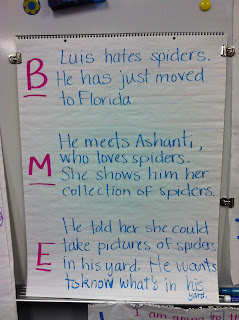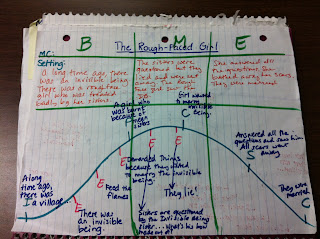Today was a normal day...as normal as our teaching days can be! No two days are ever the same, are they? We have plans and routines, but something always seems to be different. For me, today began with a different homeroom. My team teacher and I started "flipping" again. One week, I start with her homeroom, the next week, I begin my day with my homeroom. There's a formal name for it...I just don't remember right now! (I'm watching "How To Train Your Dragon" as I type, so I get sidetracked! Not unlike my students, I suppose!) We do this because, even though our time allotments are about the same in the morning and afternoon, the morning always seems more productive. I think that's why senior citizens wake up a 4 am...more productive!! Haha (Ewwww...he just ate a regurgitated fish!!!) Sorry for getting off task!
We worked on plot today. This is a reteach time, in preparation for the Reading STAAR, and most of my students remembered the lesson we had months ago. We talk about plot all the time, but maybe I don't use the term "plot" enough. That is definitely something I need to work on...the technical language. That's sometimes difficult with ELLs.
I love teaching plot and story structure. It's so easy to lead into details and main idea. Here is how I teach it:
As you can see, I had to do this lesson for two classes, so I just flipped the chart around. Since the new assessments use paraphrasing for summarizing, I changed my method of teaching plot. Before, on the TAKS, students could be taught to find the summary by finding specific sentences within the text. Not anymore. So I teach the students that, in most stories, the beginning of the summary should stop after the problem, the middle should stop after the climax, and the end includes the resolution and conclusion. We used this chart, along with our story, to come up with a summary. I had the students change the first two sentences around in their final copy. Here is our class summary and some examples of student work:
The last one is actually a copy I pulled from my Reading Response Journal (yes, I do one with the students) that we did back in October.
I feel this method really helps my students grasp the concept. And it definitely helps with main idea, details, and sequencing.
I am worried about one of my students and his lack of homework participation. I've made phone calls home, sat him out of recess, and assigned him Academic Completion Time after school. I've also offered rewards and lots of praise when he does do his homework. But he just doesn't keep up. It's very frustrating because, when he studies and does his work, it is really good. However, no homework results in 0's and 16's on his Friday assessments. We have a parent conference set up (it's been phone calls lately) but I don't know if it will make a difference. If anyone has any ideas, please share!!! He NEEDS to be successful for his own self-esteem.
So, I end with a quote by the certified genius, Unknown. He/she has to be a genius for having such a wonderful quote...
"Never give up on anyone. Miracles happen every day."
Truer words about my kiddos have never been spoken...
Well, Hiccup is riding Toothless and discovering the dragon hive...this is getting good...gotta go!
Always,
Tammy




Thanks for sharing. I enjoyed taking your info, quote, and just reading your letter... feel encouraged.
ReplyDelete